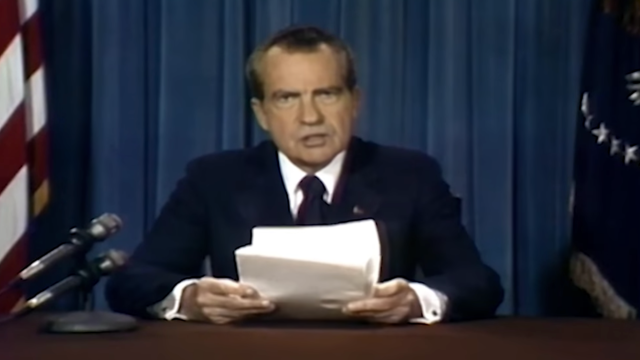A prepared speech that President Richard Nixon thankfully never had to make has been brought to life in an art project that poses the question: Can a deepfake rewrite history?
As Apollo 11 astronauts Neil Armstrong, Buzz Aldrin, and Michael Collins travelled towards the Moon in July 1969, President Richard Nixon had a speech ready just in case the mission ended in disaster. The undelivered speech, written by presidential speechwriter William Safire, was stored in the National Archives and finally made public in 1999 during the 30th anniversary of the historic Apollo 11 landing.
But what if the Apollo mission ended in a catastrophe—a distinct possibility given the tremendous risks? What would the speech have looked like on TV, and how would Nixon’s words have sounded like to American ears? A new art installation called In the Event of a Moon Disaster Project imagines this exact scenario by applying a rather infamous emerging technology: deepfake videos.
Deepfakes, of course, are those pernicious videos in which, usually, celebrities, politicians, and other high-status individuals do and say things they most certainly did not. A typical deepfake involves pre-existing footage of an individual, such as Barack Obama or Vladimir Putin, and an artificial neural network does the rest, modifying both the audio and the video to twist a person’s words. In this case, the creators of the Moon Disaster project applied Nixon’s unsaid Apollo 11 failure speech to archival footage of the U.S. president—and it’s actually quite realistic.
“Good evening, my fellow Americans,” says the manipulated Nixon in the deepfake. “Fate has ordained that the men who went to the Moon to explore in peace will stay on the Moon to rest in peace.”
Had Apollo 11 gone wrong, this speech would’ve been delivered around July 20, 1969—the date of the first Moon landing.
This project was produced at the MIT Centre for Advances Virtuality and directed by Francesca Panetta, the centre’s creative director, and Halsey Burgund, an MIT research affiliate. The video is currently on display at the International Documentary Film Festival (IDFA) Amsterdam DocLab, and it premiered on November 22, 2019. The deepfake video is part of a physical art installation that recreates a stereotypical American living room from the late 1960s. The DocLab includes 30 interactive art pieces, virtual reality installations, and some innovative AI experiments.
The purpose of the Moon Disaster project was to showcase the “possibilities of deepfake technologies by reimagining this seminal event,” according to the Moon Disaster website. “We invite you into this alternative history and ask us all to consider how new technologies can bend, redirect and obfuscate the truth around us.”
[referenced url=” thumb=” title=” excerpt=”]
Indeed, this art project illustrates the power of deepfake videos to alter our sense of not just reality, but also the past. Deepfake videos are still largely unconvincing for the most part, but the day is fast approaching when these videos enter into that dreaded uncanny valley. At that point, we’ll have to lean on countermeasures, namely other AI, to tell us which videos are real and which are fake. Get ready for a super-weird future in which virtually nothing can be taken for granted—not even the past.
